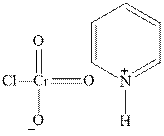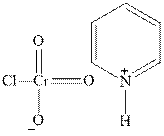
Concept explainers
(a)
Interpretation:The best method for synthesis of indicated

Concept introduction:Chromium reagents such as
Aqueous sodium dichromate is the reagent added for oxidation of
(b)
Interpretation:The best method for synthesis of indicated acid from appropriate alcohol should be devised.

Concept introduction:Chromium reagents such as
Since
(c)
Interpretation: The best method for synthesis of indicated aldehyde from appropriate alcohol should be devised.

Concept introduction:PCC is useful for selective oxidation of primary alcohol to corresponding aldehydes. The tertiary alcohols have no hydrogen so it cannot be oxidized. The structure of pyridinium chlorochromate is as follows:

(d)
Interpretation: The best method for synthesis of indicated ketone from appropriate alcohol should be outlined.

Concept introduction:Chromium reagents such as
Aqueous sodium dichromate is the reagent added for oxidation of
(e)
Interpretation: The best method for synthesis of indicated aldehyde from appropriate alcohol should be devised.

Concept introduction: PCC is pyridinium chlorochromate is useful for selective oxidation of primary alcohol to corresponding aldehydes. The tertiary alcohols have no hydrogen so it cannot be oxidized. The structure of pyridinium chlorochromate is as follows:

Want to see the full answer?
Check out a sample textbook solution
Chapter 8 Solutions
Organic Chemistry: Structure and Function
- There are two possible Grignard reactions that lead to the given alcohol. Select the reactant needed for each of the indicated Grignard reagents. MgBr H OH OH H 1) ? 2) H3O* OHarrow_forwardWhat is the functional group of the major organic product of the following reaction? Focus on the functional group that changes in the reaction. OH ether ketone ester O aldehyde OH CH₂OH HC1arrow_forwardWhat is the IUPAC name for the following compound? CI 4-ethyl-3,5-dimethylhexanoyl chloride O 3-ethyl-2,4-dimethylhexanoyl chloride 4-ethyl-3,5-dimethylpentanoyl chloride O 3-ethyl-2,4-dimethylpentanoyl chloridearrow_forward
- What is the product formed in the following reaction? HO POCI3 pyridine cyclohexanolarrow_forwardWhat is the IUPAC name for the following compound? O t-butyl cyclohexanecarboxylate O 3-cyclohexyl-2-oxy-tert-butanone O butyl cyclohexanone O t-butyl cyclohexanone O butyl cyclohexanecarboxylatearrow_forwardList the following compounds in order of increasing water solubility: a.ethoxyethane b.propanoic acid c.pentane d.1 butanolarrow_forward
 Chemistry & Chemical ReactivityChemistryISBN:9781133949640Author:John C. Kotz, Paul M. Treichel, John Townsend, David TreichelPublisher:Cengage Learning
Chemistry & Chemical ReactivityChemistryISBN:9781133949640Author:John C. Kotz, Paul M. Treichel, John Townsend, David TreichelPublisher:Cengage Learning Chemistry & Chemical ReactivityChemistryISBN:9781337399074Author:John C. Kotz, Paul M. Treichel, John Townsend, David TreichelPublisher:Cengage Learning
Chemistry & Chemical ReactivityChemistryISBN:9781337399074Author:John C. Kotz, Paul M. Treichel, John Townsend, David TreichelPublisher:Cengage Learning Organic And Biological ChemistryChemistryISBN:9781305081079Author:STOKER, H. Stephen (howard Stephen)Publisher:Cengage Learning,
Organic And Biological ChemistryChemistryISBN:9781305081079Author:STOKER, H. Stephen (howard Stephen)Publisher:Cengage Learning, General, Organic, and Biological ChemistryChemistryISBN:9781285853918Author:H. Stephen StokerPublisher:Cengage Learning
General, Organic, and Biological ChemistryChemistryISBN:9781285853918Author:H. Stephen StokerPublisher:Cengage Learning Chemistry for Today: General, Organic, and Bioche...ChemistryISBN:9781305960060Author:Spencer L. Seager, Michael R. Slabaugh, Maren S. HansenPublisher:Cengage Learning
Chemistry for Today: General, Organic, and Bioche...ChemistryISBN:9781305960060Author:Spencer L. Seager, Michael R. Slabaugh, Maren S. HansenPublisher:Cengage Learning





